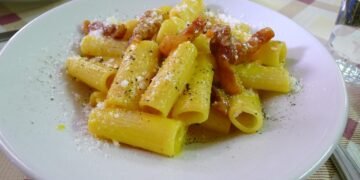Italian Rice: The Staple Behind Many Classic Dishes
Amongst the plethora of ingredients that are widely used in Italian cooking, often the humble grain of rice is overlooked. Although pasta is typically the culinary symbol of Italy, rice plays an equally significant role in creating some of the most iconic, and delicious Italian dishes. Let’s delve into the rich world of Italian rice, exploring its unique qualities, regional variations, and the classic dishes it helps create.
The Importance of Rice in Italian Cuisine
In stark contrast to the dominant position that pasta holds in international perceptions of Italian cuisine, the country has a deep-rooted history of rice cultivation and a rich array of traditional rice dishes. The importance of rice in Italian cuisine lies not only in its versatility but also in its historical and economic significance.
Cultivation and Historical Significance
Lombardy, Piedmont, and Veneto, regions located in the northern part of Italy, are the primary rice-growing zones. The Po Valley, an agricultural area that stretches across these regions, provide the perfect conditions for rice cultivation. Italian rice farming traces its roots back to the Middle Ages when Arab merchants introduced the grain to Sicily and Spain. From there, it slowly spread across the country, primarily to the northern regions. Today, Italy is the largest rice producer in Europe.
| Region | Rice Production |
|---|---|
| Piedmont | 20% |
| Lombardy | 40% |
| Veneto | 30% |
Varieties of Italian Rice
There are several distinctive varieties of Italian rice, each with its texture, taste, and ideal use. Among them, Arborio, Carnaroli, and Vialone Nano are the most famous and widely used in Italian culinary traditions.
Arborio
Named after the town of Arborio in the Piedmont region, Arborio rice is a medium-to-long-grain rice renowned for its starchy, creamy texture. It’s the most common Italian rice used worldwide, especially in risotto dishes.
Carnaroli
Often called the “king of rice,” Carnaroli is highly prized for its larger grain, higher starch content, and firmer texture. It’s excellent at retaining its shape and texture in creamy dishes, making it the preferred choice for risotto in many parts of Italy.
Vialone Nano
Originating from the Verona, Vialone Nano is a medium grain rice with an exceptional ability to absorb flavors. It is the preferred choice for many traditional risotto dishes in the Veneto region.
Classic Italian Dishes Made with Rice
Rice is at the heart of many beloved Italian dishes. From the creamy layers of risotto to the hearty stuffing of arancini, Italian rice brings distinct tastes and textures that make the cuisine so universally loved.
Risotto
Risotto is probably the most recognizable rice dish from Italy. A comforting dish that is both versatile and delicious, risotto highlights the creaminess of Italian rice. Its preparation involves the gradual addition of broth to rice while stirring. This slow cooking releases the starch and creates the characteristic creaminess of the dish. There are many regional variations of risotto, from Risotto alla Milanese flavored with saffron to Seafood Risotto from the Venetian coast.
Arancini
Hailing from Sicily, Arancini are golden, breaded, and fried rice balls. They are usually filled with ragù, mozzarella, and peas. The outer crust is crispy and the inside is a glorious mix of savoury rice, meat, and melted cheese. They are named ‘Arancini’ because they resemble little oranges in shape and color.
Supplì
Supplì are similar to Arancini, with the main difference being their origin and shape. Supplì are native to Rome and characterized by an elongated, rather than round shape. They’re traditionally stuffed with tomato risotto and a piece of mozzarella in the center, which stretches beautifully when bitten into, much like a telephone cord – giving them their full name ‘Supplì al telefono’.
Conclusion
Italian rice is a fundamental part of Italian gastronomy. Its different varieties, each with unique characteristics, make it possible to create a range of traditional dishes that captivate the palate. From the poise and sophistication of a creamy risotto to the homely delight of a crispy Arancini ball, these dishes continue to pay homage to the legacy of Italian rice.
The Art of Selecting Italian Rice
Selecting the best Italian rice for your dish is an art in its own right. The staples of Italian cuisine require specific types of rice to unlock unique textures and flavors. Some typical Italian rice varieties include Arborio, Carnaroli, Vialone Nano, and Baldo. These grains have distinctive properties and are often used in specific types of dishes.
Arborio Rice
Arborio, named after the town of Arborio in Italy’s Piedmont region, is arguably the most common variety. Known for its large, plump grains and a high starch content, it creates a creamy consistency when cooked – making it perfect for risotto.
Carnaroli Rice
Another popular choice, often touted as the ‘king of rice,’ is Carnaroli. This variety has a firmer texture and longer grains than Arborio, making it great for risotto dishes that require a little more bite. Its ability to absorb flavours without losing its shape is legendary among Italian chefs.
Vialone Nano and Baldo Rice
Vialone Nano is preferred in Veneto region for its ability to absorb liquids and sauces making it ideal for seafood risottos. Also, Baldo rice, with its high-starch content and able to absorb flavours effectively, is often used in salads or traditional risottos.
The Role of Italian Rice in Traditional Dishes
Italian rice is not only served as a side dish but also plays a central role in a variety of authentic local dishes.
Risotto
The most famous dish is, without a doubt, risotto. This creamy rice-based dish can have a wide variety of flavourings, from saffron-infused Risotto alla Milanese to mushroom-packed Risotto ai Funghi.
Rice salads and soups
Italian rice is also commonly used in cold rice salads, warm in wholesome soups, or even made into a delicious rice cake.
Italian Rice beyond Traditional Cuisine
Italian rice also lends itself to a range of delicious desserts. The traditional rice pudding, ‘Budino di Riso’, is a testament to the charm of Italian cuisine’s simple ingredients and preparation methods.
Italian Rice in Desserts
Moreover, Italian rice is transformed into a mouthwatering component of desserts like Rice Gelato, a comforting cold treat full of the pure flavor of Carnaroli or Arborio rice.
Italian Rice in Drinks
Interestingly, Italian rice also finds its way into the world of beverages. For example, some traditional Italian drinks such as ‘Horchata’ are made from fermented rice, offering a unique way to enjoy this versatile staple.
In conclusion, Italian rice is a linchpin in Italian cuisine, holding together traditional dishes and providing a canvas for a multitude of flavors and textures. The choice of the type of rice significantly impacts the final dish, from a creamy risotto to a velvety gelato, making Italian rice a truly versatile culinary hero.





































